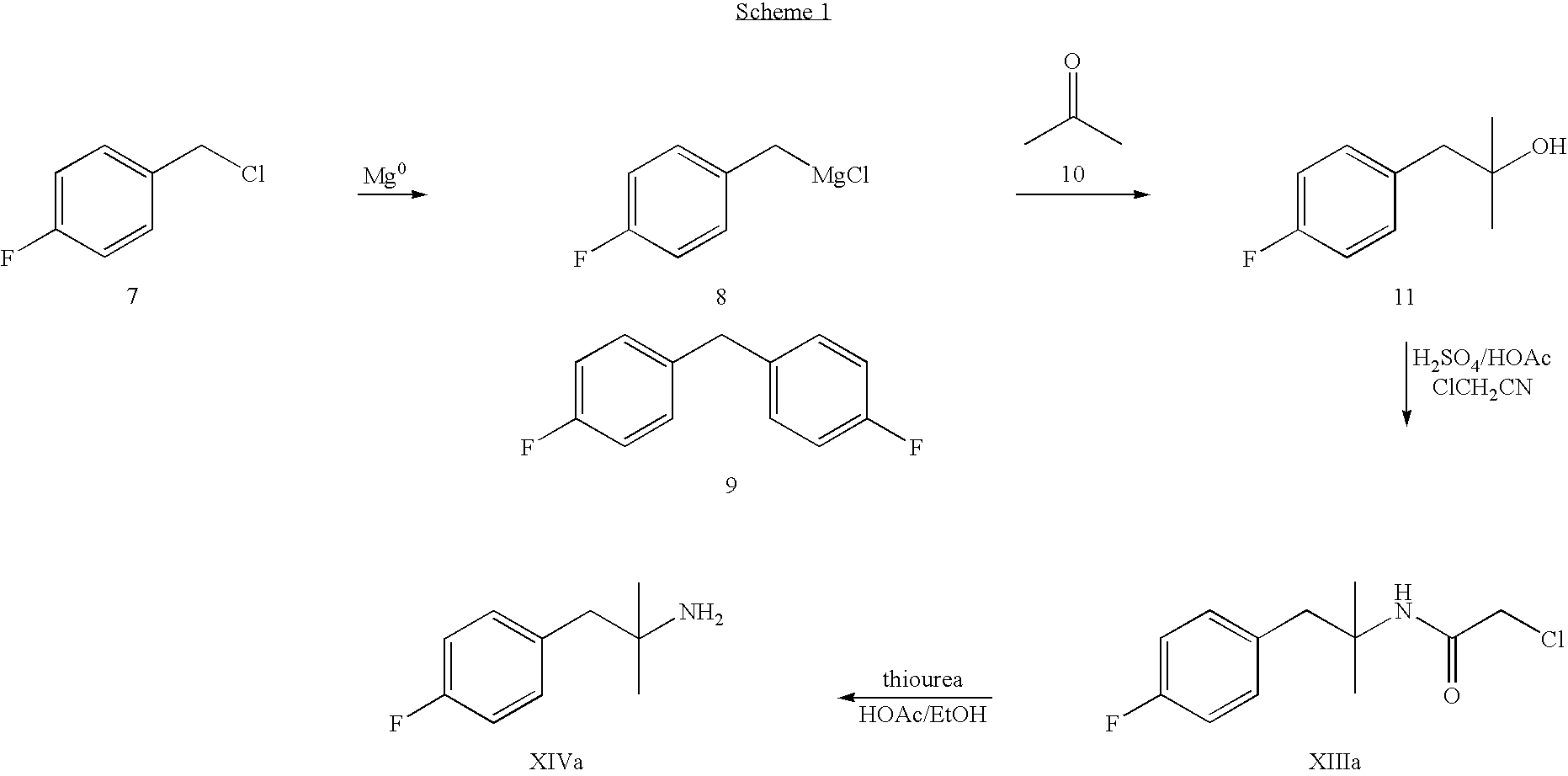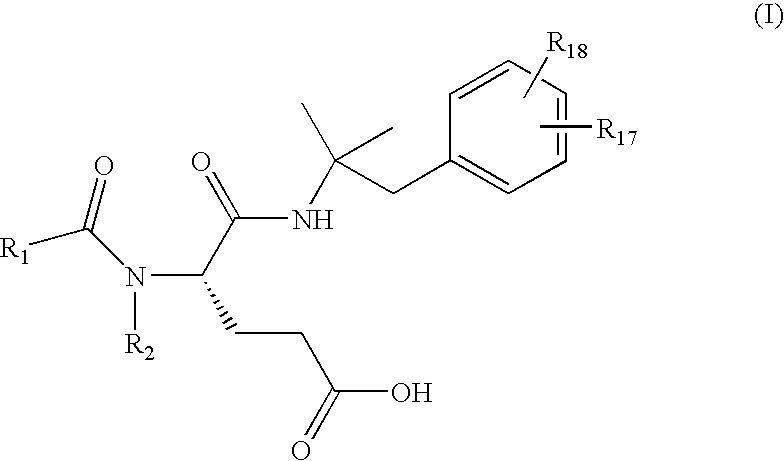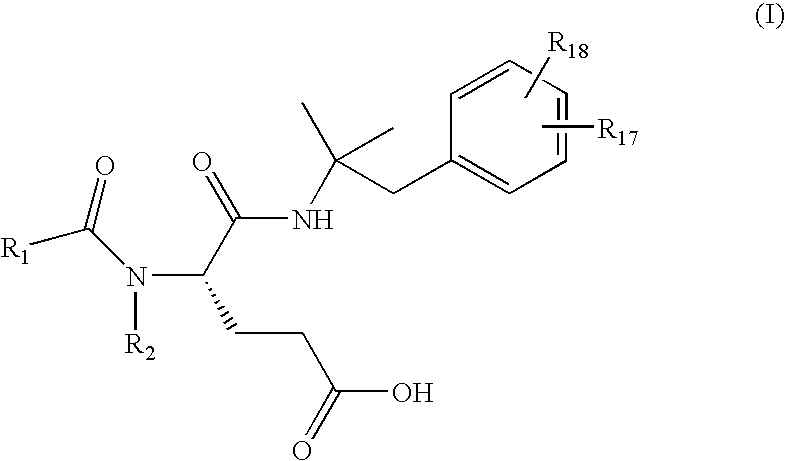Methods for preparing glutamic acid derivatives and intermediates thereof
a technology of glutamic acid and derivatives, which is applied in the field of preparation of glutamic acid derivatives and intermediates thereof, can solve the problems of severe reduction of quality of life, difficult control of grignard steps, and deficiencies in biomechanical characteristics of cartilag
- Summary
- Abstract
- Description
- Claims
- Application Information
AI Technical Summary
Problems solved by technology
Method used
Image
Examples
example 1
Preparation of 1-(4-fluorophenyl)-2-methyl-1-propanol
[0204]4-Fluorobenzaldehyde (186.0 grams, 1.50 moles) was added dropwise to a solution of isopropylmagnesium chloride in tetrahydrofuran (2.0 M, 787.8 grams, 1.62 moles) maintained at about 0°-10° C. After completion of the addition, the reaction mixture was allowed to stir at 0°-10° C. for about 2 hr.
[0205]The reaction mixture was transferred over about 70 minutes into a 3-liter, 4-neck roundbottom flask (equipped with a mechanical agitator, temperature probe, and nitrogen inlet) containing a solution of glacial acetic acid (126 ml) in water (1.06 L) maintained at about 5°-15° C. The flask and transfer lines were rinsed into the quench vessel with THF. The resulting two-phase mixture was allowed to stir for about 15 minutes at about 5°-15° C., and then the phases were separated. The organic phase was then washed with 5% NaCl solution.
[0206]The organic phase was concentrated under reduced pressure. Glacial acetic acid (253 grams, 2...
example 2
Preparation of Chloro-N-[2-(4-fluorophenyl)-1,1-dimethylethyl]acetamide
[0207]A 500-ml, 4-neck roundbottom flask was equipped with a mechanical agitator, temperature probe, nitrogen inlet, and 125-ml liquid addition funnel. To the flask was charged a solution of 1-(4-fluorophenyl)-2-methyl-1-propanol in acetic acid (135 grams, 127 mL) as prepared in the first step. Glacial acetic acid (90 grams, 85.8 ml) was then charged to the flask. The resulting mixture was cooled to about 0°-5° C. The 125-ml liquid addition funnel was charged with 32% sulfuric acid (83.7 grams). The sulfuric acid was added dropwise to the reaction mixture. During this addition, the reaction temperature was maintained at about 0°-10° C. After completion of the addition, the reaction mixture was allowed to warm to about 20°-25° C. over about 40 minutes, and then stirred at about 20°-25° C. for over 20 hr. The reaction mixture was then transferred over about 55 minutes into a 500-ml round bottom flask containing chl...
example 3
Preparation of 2-(4-fluorophenyl)-1′-dimethylethylamine hydrochloride
[0209]A solution of chloro-N-[2-(4-fluorophenyl)-1,1-dimethylethyl]acetamide (71.4 g, 0.293 mol) in ethanol (125 ml) and acetic acid (55 ml) was added dropwise to a stirred suspension of thiourea (26.7 g, 0.351 mol) in ethanol (125 ml) at about 78°-86° C. The resulting mixture was allowed to stir at about 80°-86° C. for about 4 hours. The reaction was monitored for completion by HPLC.
[0210]When the reaction was complete, the mixture was cooled to about 20°-25° C. and then filtered. The reaction flask and filter cake were rinsed with ethanol, and then the filtrate was concentrated under vacuum. Water (about 200 ml) and toluene (about 200 ml) were added and the phases were thoroughly mixed. The phases were separated, and the upper organic phase was discarded. Toluene (about 400 ml) was added to the lower aqueous phase, and the resulting mixture was cooled to about 5°-10° C. Sodium hydroxide solution (50% w / w, about 5...
PUM
| Property | Measurement | Unit |
|---|---|---|
| volume | aaaaa | aaaaa |
| volume | aaaaa | aaaaa |
| temperature | aaaaa | aaaaa |
Abstract
Description
Claims
Application Information
 Login to View More
Login to View More - R&D
- Intellectual Property
- Life Sciences
- Materials
- Tech Scout
- Unparalleled Data Quality
- Higher Quality Content
- 60% Fewer Hallucinations
Browse by: Latest US Patents, China's latest patents, Technical Efficacy Thesaurus, Application Domain, Technology Topic, Popular Technical Reports.
© 2025 PatSnap. All rights reserved.Legal|Privacy policy|Modern Slavery Act Transparency Statement|Sitemap|About US| Contact US: help@patsnap.com



